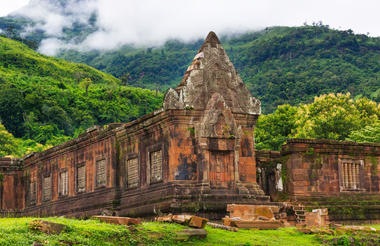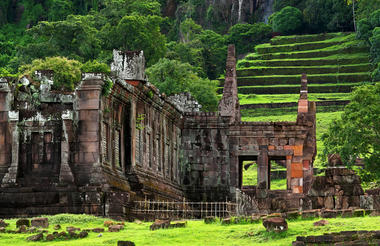Wedged between a number of larger neighbouring countries, Laos is often overlooked in favour of tourism giants such as Thailand and Vietnam. But these travellers are missing out on an extraordinarily scenic and culturally rich destination. Laos boasts a reputation as the least visited, least Westernised, and most untouched of all Indochinese nations. Only time will tell how long this will last, but while it does, visitors who choose to explore this nation’s remote areas will be richly rewarded. Laos’ primary drawcard is undoubtedly the mighty Mekong River which traverses the length of the country and is considered the second most biodiverse river in the world. In the north, the landscape is characterised by little-explored jungle-clad mountainous areas where visitors can witness the intriguing cultures of the various hill tribes that populate this region. Travellers on the hunt for cultural interest should head for the bustling capital of Vientiane, with its innumerable temples and Buddhist monuments. It is this variety of exotic wildlife, remote wilderness and remarkable cultural treasures that make Laos a truly unique and unforgettable holiday destination.
A charming town with elegant historical architecture and a distinctly French flavour, Luang Prabang in northern Laos is filled with interesting museums, bustling markets and traditional shops. 33 Buddhist temples dot the city.; the Haw Kham Royal Palace Museum and Wat Xieng Thong temple give travellers some background on and history of the Laotian people. Beyond the city, breathtaking nature and ancient sites await. Those who visit the Pak Ou Caves can see hundreds of Buddha statues accumulated there through the ages. The 180-foot Kuang Si Waterfalls, an hour’s drive out of the city, is one of the region’s natural highlights, with its layer upon cascading layer of turquoise pools and torrents.



ViVientiane, the capital and largest city of Laos, offers a refreshing contrast to many Southeast Asian capitals—uncrowded, unhurried and imbued with a gentle, understated elegance. Set along the Mekong River, the city blends leafy boulevards, serene temples and evocative French-era architecture with a relaxed riverside lifestyle. Its spiritual heart is Pha That Luang, the nation’s most revered monument, a radiant 16th-century golden stupa symbolising Lao identity and Buddhist devotion. Travellers can wander between pavement cafés, atmospheric night markets and riverside restaurants, all of which reflect the city’s famously tranquil rhythm. Cultural highlights include the Laos National Museum, where thoughtfully curated exhibits trace the country’s long and complex history. With its calm disposition, historic charm and warm hospitality, Vientiane offers a captivating introduction to the soul of Laos.



Surrounded by mist-draped limestone karsts, tranquil rice paddies, mysterious caves and ancient ruins, Vang Vieng is a vibrant jungle town set amid some of Laos’s most breathtaking scenery. Although the once-infamous river party scene has been reined in by new regulations, the town remains a premier hub for soft adventure—offering cycling, caving, tubing, rafting, kayaking, zip-lining and countless hiking trails through cinematic landscapes. Between excursions, travellers can unwind in the town’s growing collection of boutique hotels and international restaurants, which make it a comfortable base for exploring the region’s natural wonders. Sunset Hill offers one of Vang Vieng’s most striking viewpoints, while the area’s aquamarine lagoons and spring-fed swimming holes invite dreamy, refreshing dips. Combining raw natural beauty with just the right amount of comfort and charm, Vang Vieng continues to captivate visitors seeking adventure framed by extraordinary scenery.



As previously described



Wedged between a number of larger neighbouring countries, Laos is often overlooked in favour of tourism giants such as Thailand and Vietnam. But these travellers are missing out on an extraordinarily scenic and culturally rich destination. Laos boasts a reputation as the least visited, least Westernised, and most untouched of all Indochinese nations. Only time will tell how long this will last, but while it does, visitors who choose to explore this nation’s remote areas will be richly rewarded. Laos’ primary drawcard is undoubtedly the mighty Mekong River which traverses the length of the country and is considered the second most biodiverse river in the world. In the north, the landscape is characterised by little-explored jungle-clad mountainous areas where visitors can witness the intriguing cultures of the various hill tribes that populate this region. Travellers on the hunt for cultural interest should head for the bustling capital of Vientiane, with its innumerable temples and Buddhist monuments. It is this variety of exotic wildlife, remote wilderness and remarkable cultural treasures that make Laos a truly unique and unforgettable holiday destination.



Serene and unpretentious, Thakhek rests along the Mekong River opposite the Thai town of Nakhon Phanom and serves as the ideal launching point for one of Laos’s great natural wonders: the spectacular Konglor Cave. Set within the Phou Hin Bun National Biodiversity Conservation Area, this immense limestone cavern winds for nearly 8 kilometres through the mountains, soaring up to 50 metres high in places and revealing extraordinary displays of stalactites and stalagmites. Visitors enter by boat along the Hin Bun River, which flows through the entire length of the cave—an otherworldly journey through cool darkness and cathedral-like chambers. Beyond Konglor itself, the surrounding national park offers its own allure, cloaked in ancient rainforest and dotted with dramatic karst formations, glittering pools and hidden lakes. Quiet, scenic and full of natural marvels, Thakhek is a rewarding base for exploring one of central Laos’s most remarkable landscapes.



Situated along the banks of the Mekong River in southern Laos, Muang Champassak is a serene riverside town layered with history and quiet charm. Once a royal capital, it remains a soulful retreat framed by traditional villages and gentle rural life. Its star attraction is Vat Phou, an ancient Khmer temple complex and UNESCO World Heritage Site that predates Angkor Wat—an evocative maze of weathered sanctuaries, sacred springs and sweeping Mekong views. Days here unfold slowly: cycle past French colonial buildings, wander sleepy lanes shaded by tamarind trees, or take a tranquil boat trip along the river. With warm hospitality and a deeply relaxed atmosphere, Muang Champassak offers a graceful blend of culture, nature and unhurried riverfront beauty.









